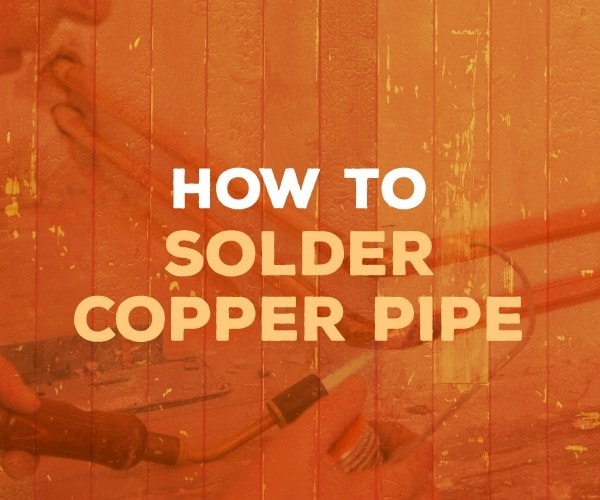Learning how to solder copper pipe is an important skill for any homeowner, and being able to sweat your own pipes can save you thousands in plumbing bills over the life of your home. While you may be a little nervous about tackling plumbing jobs without experience, this is one job that anyone can learn by following a few simple steps.
Read the guide below, and by the time you’re finished, you should feel confident that you know how to solder copper pipe.
What You’ll Need
Thankfully, there are only a few supplies you’ll need for this job. Each of the tools you’re going to need is inexpensive, and they come in handy, so you should consider buying them if you don’t already have them available. Here’s what you’ll need:
- Propane torch
- Lead-free solder
- Flux
- Flux brush
- Measuring tape
- Sharpie marker
- Pipe cutter
- Pipe fitting brush
- Emery cloth
- Pipe deburrer
- Work gloves
Step I: Cutting the Pipe
Depending on the job you’re working on, you may not be cutting any pipe at all. But, for most jobs, you’ll be cutting the pipe to size.
Before you begin, make sure to shut off your water supply.
Measure your project to see how long your length of pipe will be, and mark your measurement on the pipe using a marker.
Then, take your pipe cutter and attach it to the pipe at the line you’ve marked. Spin the pipe cutter a turn or two and then tighten the cutter about a quarter turn. Spin the pipe cutter another turn, and retighten the cutter. Repeat this process until you’ve cut through the pipe.
Step II: Preparing the Pipe
Once your pipe is at the proper length, you’ll need to do some preparation to ensure a perfect leak-proof joint. This step is key to the success of your entire job, so make sure to pay special attention.
First, you’ll need to deburr the inside of the pipe. While the pipe may look smooth after you’ve cut it, there’s a bit of copper material that’s been pushed inward by the cutter as it worked its way through the pipe. This burr must be removed for the water to flow properly.
Place your deburrer inside the pipe (your pipe cutter or fitting brush may have one on the tool) and turn the tool a time or two to remove the burr.
Next, you’ll want to use your emery cloth to remove any corrosion from the exterior of the pipe. The emery cloth also roughs up the surface of the pipe, which makes it easier for the solder to adhere.
Place the emery cloth around the end of the pipe and scrub, like you would if you were trying to clean a stain. You’ll know you're done when the pipe starts to shine. Do this to the bottom 1” or so of each end of pipe.
Now, take your fitting brush and use it to clean the inside of your pipe fitting. If you don’t have a fitting brush, you can wrap some emery cloth around your finger and use your finger to clean the inside of the fitting.
Step III: Flux the Pipe
Now that both your pipe and fitting are cleaned and prepared, you’re almost ready to sweat the joint.
Now, you’ll flux the pipe. Flux acts as a sort of glue that helps the solder adhere to the surface it’s been melted onto, and it’s critical to building a leak-proof joint.
Dip your flux brush into the flux and brush a thin, even layer of flux on the bottom 1” of your pipe. Repeat this for the other side of the pipe.
Next, place the pipe inside of the fitting until it’s seated at full depth. Take a rag and wipe away any excess flux. Repeat this for the other side of the pipe.
Step IV: Sweating the Pipe
Finally, we’re ready to solder the pipe together.
Before you turn on your torch, get the rest of your supplies ready. Unwind several inches of solder, and crimp the last 2” or so into a 90-degree angle. Make sure you’re using lead-free solder since you don’t want this stuff leaching into your drinking water.
Put on your work gloves, and get your torch started. Adjust the torch so that you have about a 2” cone. Begin to heat the pipe fitting. Hold the torch about an inch from the fitting and continue to move the flame around to ensure that you’re heating the fitting evenly.
For copper fittings, your pipe will be hot enough to solder in about a minute or less, depending on the heat of your torch. For brass fittings, it can take significantly longer for the brass fitting to reach the solder’s melting point, so be sure to take extra time when working with brass.
Take your solder and press the tip against the joint on the opposite side of the flame until the solder begins to melt. Move the solder forward, so about ½-¾” of solder is melted into the joint.
Check to make sure that the solder joint is complete across the circumference of the pipe. If the joint looks good, you’re all set.
Final Word
Learning how to solder copper pipe is an important lesson you’ll need to learn to tackle plumbing tasks around the house. Fortunately, it’s an easy enough job to do, and with the tips in this guide, you should be able to sweat pipes in your sleep in no time.
Always remember to exercise extra caution when working with your propane torch.

